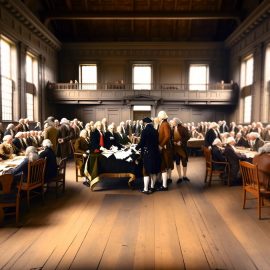
Why was Donald Trump voted into the presidency? Does it have anything to do with a historical shift in Christianity?
Following the 2016 US presidential election, pundits argued that the 81% of evangelical Christians who voted for Donald Trump over Hillary Clinton viewed him as the lesser of two evils. But, according to historian Kristin Du Mez, this explanation is misguided.
Continue reading for our Jesus and John Wayne book overview.
Jesus and John Wayne Book Overview
Du Mez argues that evangelicals endorsed Trump because he was the paradigm of militant masculinity that became orthodox among evangelicals in the last century. In Jesus and John Wayne (2020), Du Mez traces the development of evangelicals’ conception of masculinity since the 1900s, outlining how the genteel masculinity of Victorian era Christianity transformed into the militaristic masculinity that led evangelicals to embrace Trump wholeheartedly.
Our Jesus and John Wayne book overview organizes Du Mez’s analysis into four historical eras of evangelical masculinity. We’ll discuss:
- How the first and second World Wars in the 1900s caused evangelicals to shift toward a militant view of masculinity to address severe international threats.
- How perceived threats abroad in the form of the Vietnam War and domestically in the form of the feminist movement led evangelicals to double down on their conception of masculinity in the 1960s and ’70s.
- How a lack of a US military opponent in the ’90s caused this conception to soften.
- How 9/11 caused a return to the previous militaristic view of masculinity that, coupled with a sense of embattlement following Barack Obama’s presidency, eventually led evangelicals to support Trump in 2020.
As a professor of history and gender studies at Calvin University, Du Mez brings academic rigor and comprehensive research to her arguments throughout Jesus and John Wayne—the book that catapulted Du Mez to the forefront of Christian scholarship. Moreover, having written editorials for outlets like The Washington Post and Christianity Today, Du Mez is an expert at distilling academic research into accessible prose for non-experts.
(Shortform note: Although Du Mez references Western and war movie star John Wayne as a symbol of the militant masculinity she says took hold over the last century, Wayne doesn’t play a major role in the book. Instead, as we’ll see, Du Mez focuses mostly on influential figures within the evangelical community.)
Evangelical Masculinity During WWI and WWII
According to Du Mez, World War I (1914-18) and World War II (1939-45) significantly altered the trajectory of 20th- and 21st-century evangelicalism. We’ll outline the evolution of evangelical masculinity in the first half of the 20th century, highlighting how it changed between the Victorian era and the peak of WWII.
Victorian Era Christianity and Its Downfall Prior to WWI
Du Mez contends that, to understand the development of evangelicalism during the first and second World Wars, it’s helpful to first understand the state of evangelical Christianity during the preceding Victorian era—the time between the early 19th and early 20th century that roughly corresponds to Queen Victoria’s reign in England. She argues that Victorian era evangelicalism included a genteel notion of masculinity that eventually gave way to Teddy Roosevelt and the “muscular Christianity” movement.
Du Mez points out that, throughout the 19th century, men mostly worked hands-on jobs such as farming or operating small businesses. Virtues like self-discipline were considered essential to masculinity, as those virtues were essential to thriving as a businessman or an agrarian worker. The ideal Christian man was therefore a gentleman who worked hard and practiced restraint.
However, Du Mez maintains that this model of masculinity began to erode during the late 1890s, as the evolving US economy changed the nature of men’s jobs. Rather than working hands-on jobs, men migrated to cities and began working corporate jobs in offices. In turn, for many men who had previously identified their masculinity with their work, this sense of masculinity felt threatened as the new office jobs didn’t require the same manly strength as their previous work.
Du Mez says that, under 26th US President Teddy Roosevelt, a new brand of rugged Christian masculinity arose in response to this perceived threat. She notes that Roosevelt’s election in 1901 popularized his conception of masculinity, where men were akin to rough Western cowboys who used violence to protect the innocent. Moreover, she points out that Roosevelt’s rugged conception of masculinity took on a distinctly evangelical flavor through the “muscular Christianity” movement, in which evangelical men rejected pacifism and instead embraced an aggressive view of masculinity that justified violence against one’s enemies in war.
How WWI Undermined Militant Christian Masculinity
Du Mez argues that while the prospect of WWI stoked the flames of militant masculinity, the war’s reality had the opposite effect: The horrors of WWI cooled the enthusiasm for militant masculinity, causing a shift toward the paradigm of the Christian businessman.
Du Mez explains that, at the end of WWI, Americans recognized the war’s immense cost in bloodshed and carnage with no apparent payoff. Although WWI was billed as the war to end all wars, international conflict and tensions remained high after its conclusion. She points out that, for progressive Protestants in particular—a group that had strongly supported the war before its onset—the destruction wrought by WWI left them disillusioned. Protestant leader Sherwood Eddy, for instance, commented that after WWI, he realized that the alleged goals of the war—to end war for good and make militarism moot—all fell short.
According to Du Mez, the war’s aftermath caused evangelicals to exalt successful business executives as the paradigm of masculinity. For example, she notes that Bruce Barton’s 1925 bestseller, The Man Nobody Knows, portrayed Jesus as the world’s savviest businessman. Further, Barton emphasized Jesus’ strength—understanding strength in a business context, rather than a militaristic context. Evangelical men, according to Barton, should therefore strive to exemplify Jesus’ decisiveness and charisma in business contexts.
The Renewal of Militant Christian Masculinity in WWII
Although WWI had robbed evangelicals’ hyper-aggressive conception of masculinity of its allure, Du Mez contends that the onset of WWII allowed this conception to rear its head again. She argues that, in the face of Nazi Germany and the Axis powers, evangelical circles once more promoted militant masculinity.
According to Du Mez, Japan’s attack on Pearl Harbor in December 1941—which prompted the US to join WWII the following day—was the watershed moment that shifted evangelical thought about the war. Whereas previously, the memory of WWI had kept evangelicals uncertain about the merits of joining WWII, Pearl Harbor convinced them that the Axis forces in WWII were unequivocally evil and worthy of destruction.
Consequently, Du Mez says, the militant evangelical conception of masculinity came into vogue again, as this type of masculinity was deemed necessary to win WWII. In part to promote this masculine ideal, fundamentalist Christians—evangelicals who interpret the Bible as literal truth—created the National Association of Evangelicals (NAE) in 1942. Du Mez relates that the NAE’s cofounder Harold John Ockenga called for evangelical men to go on the offensive, both in the war but also domestically to evangelize the nation.
The Rise of Billy Graham Leading Into the Cold War
Du Mez argues that the NAE wasn’t the most powerful evangelical force promoting a tough, militaristic masculinity. That title belonged to Billy Graham, an evangelist and minister who started leading evangelical revival movements during WWII. Du Mez writes that Graham employed war and sports metaphors in his portrayals of Jesus to mass audiences—Graham likened Jesus to a “star athlete,” calling him “our great Commander” and emphasizing his immense physical strength. And, by the end of WWII, Graham had established himself as a preeminent defender of “manly evangelicalism.”
According to Du Mez, Graham’s emphasis on militaristic masculinity stretched beyond WWII and into the Cold War—the tension between the US and the communist Soviet Union that began in the late 1940s. She notes that, in Graham’s rallies, he portrayed communism as an evil force driven by Satan that threatened to annihilate the world via nuclear weapons. In turn, Graham exhorted evangelical men to protect their nation by fighting the Soviets in battle if necessary, but also by maintaining righteous homes to defeat the moral evils of communism.
Evangelical Masculinity During the 1960s and 1970s
While the threat of communism during the Cold War sustained evangelicals’ militant masculinity in the wake of WWII, Du Mez explains that additional international and domestic threats strengthened this conception of masculinity throughout the 1960s and ’70s. We’ll first examine how the US military’s failure in the Vietnam War caused evangelicals to adopt a more hostile view of masculinity, then discuss how the perceived threat of feminism led evangelicals to double down on traditional gender roles in the home.
The Impact of the Vietnam War
According to Du Mez, US participation in the Vietnam War—in which the US faced guerrilla warfare from the communist Viet Cong, which controlled Northern Vietnam—further entrenched the militant evangelical conception of masculinity.
First, Du Mez argues that, during the Vietnam War, evangelicals made excuses for atrocities perpetrated by US soldiers. For example, Lieutenant William Calley was found guilty of murdering 22 innocent Vietnamese civilians during the My Lai massacre—an episode in which US soldiers murdered around 500 Vietnamese villagers during the war. However, Du Mez notes that Billy Graham, for example, downplayed these atrocities. Graham commented that the Viet Cong had likely also committed war crimes, and even noted in The New York Times that “We have all had our Mylais in one way or another, perhaps not with guns, but we have hurt others with a thoughtless word, an arrogant act or a selfish deed.”
Further, Du Mez observes that as the Vietnam War dragged on and the US failed to defeat the Viet Cong, many Americans grew disillusioned with US involvement in the war. Evangelicals, by contrast, drew a different conclusion, arguing that the US’s inability to defeat the Vietnamese stemmed from a dearth of masculinity among US soldiers. Du Mez reports that, to remedy this problem, evangelicals maintained that fathers needed to raise their sons to become rugged defenders of freedom—for instance, fundamentalist pastor Jack Hyles exhorted evangelicals to raise boys who weren’t afraid to use violence to defend their families.
The Pushback Against the Feminist Movement
In addition to the upheaval caused by the Vietnam War, Du Mez points out that further social unrest in the ’70s stemmed from the feminist movement, which attempted to undermine traditional gender norms that confined women to the domestic sphere. She argues that, as a reaction to this movement, two sets of influential evangelicals—Marabel Morgan and Phyllis Schlafly on one hand, and Bill Gothard and James Dobson on the other—pushed back against feminism by defending traditional gender norms in marriage and in the nuclear family.
Du Mez writes that, in the ’70s, Morgan and Schlafly published influential anti-feminist books that spurred anti-feminist activism from evangelicals. For her part, Morgan argued that women ought to submit to their husbands to achieve domestic happiness because that was God’s intention for marriage (a belief known as complementarian theology). Moreover, because women ought to submit, Morgan concluded that men were required to become leaders in the domestic sphere. In a similar vein, Schlafly opposed the Equal Rights Amendment (ERA), a proposed amendment to the US Constitution that prohibited denial of equal rights on the basis of sex, arguing that the amendment falsely presupposed that women were oppressed and thus needed protection.
While Morgan and Schlafly focused largely on evangelical women, Gothard and Dobson instead geared their advice toward evangelical men, arguing that men should rule the family with an iron fist. Du Mez relates that Gothard hosted seminars with over 200,000 evangelical attendees during the 1970s, teaching that societal problems stemmed from noncompliance with authority—problems that could be solved in the domestic sphere through unflinching obedience to fathers in the home. Likewise, Dobson—who founded Focus on the Family, an evangelical organization that sought to promote traditional family structures of male breadwinners and female housewives—emphasized the father’s responsibility to discipline his children with corporal punishment (that is, spanking).
Evangelical Masculinity During the 1980s and 1990s
While opposition to the feminist movement helped spur on evangelical political engagement in the 1970s, Du Mez maintains that evangelicals became especially involved politically throughout the ’80s and ’90s. We’ll first look at the 1980 presidential election between Ronald Reagan and Jimmy Carter, which Du Mez claims was pivotal to the formation of the religious right, then examine how the lack of a concrete military opponent in the 1990s temporarily caused evangelicals to embrace a gentler masculinity devoid of its previous aggression.
The Reagan vs. Carter Election
Du Mez contends that a watershed moment for evangelical identity in the US occurred in the 1980 presidential election, which pitted Republican Ronald Reagan against incumbent Democrat Jimmy Carter. She argues that Reagan’s victory over Carter cemented the marriage between evangelicals and the political right: Even though Carter personally identified as an evangelical Christian—whereas Reagan was an infrequent churchgoer at best— evangelical voters embraced Reagan’s socially conservative policies and ruggedly masculine image.
Du Mez explains that Reagan intentionally built social capital with evangelical voters. For instance, while Reagan had previously supported the ERA as governor of California, he walked back his support while campaigning for president. Similarly, he began embracing evangelical policy points, such as supporting prayer in public schools and prohibiting abortion.
However, Du Mez suggests that what ultimately sealed the deal for Reagan with evangelical voters was his perceived masculinity. Whereas Jimmy Carter was often deemed a “wimp” by critics, Reagan seemed reminiscent of a cowboy, even owning his own ranch in California. Moreover, Du Mez writes that Reagan reinforced this masculine appearance by becoming the “tough on crime” candidate who wasn’t afraid to ruthlessly punish criminals, even using violence when needed.
Consequently, Du Mez says, when the 1980 election came to pass, Reagan won the white evangelical vote in a landslide: 67% of white evangelicals voted for Reagan, even though 50% had voted for Carter in the previous election. Du Mez relates that since that 1976 election, no Democrat has even come close to winning the majority of the evangelical vote.
The Formation of the Religious Right
Although Reagan’s election cemented the marriage between evangelicals and the right, Du Mez clarifies that two key parties laid the foundation for this religious right during the 1980s: The LaHaye family and Jerry Falwell Sr.
She notes that the LaHaye family includes Tim and Beverly LaHaye, each of whom played a role in strengthening the religious right. For his part, Tim LaHaye was a pastor whose books in the early 1980s stoked a sense of embattlement on behalf of evangelicals. He argued that progressives were undermining key aspects of evangelical life, such as education and the family, meaning evangelicals needed to align themselves with the right. Beverly LaHaye founded Concerned Women for America (CWA), an influential evangelical organization that targeted the progressive feminist agenda throughout the 1980s.
Similar to the LaHayes, Falwell Sr. was essential to bringing the religious right into the political mainstream. As Du Mez relates, he created the Moral Majority in 1979, an organization that sought to mobilize the religious right in elections throughout the 1980s. In particular, Falwell Sr. promoted a militaristic approach and advocated that America maintain a dominant military to fend off domestic and international threats, largely from Marxists who, according to Falwell, wished to undermine the evangelical family unit.
The Evangelical Shift Toward “Soft Patriarchy”
Du Mez points out that despite Falwell Sr.’s emphasis on militant masculinity, the US’s lack of a concrete military opponent throughout the 1990s caused this conception of masculinity to atrophy. Instead, evangelicals promoted a less virulent but nonetheless patriarchal view of masculinity according to which men were divinely ordained to lead in the home as servant-hearted leaders—people who lead first and foremost through serving.
According to Du Mez, this shift originated in evangelical theologians John Piper and Wayne Grudem’s 1991 book, Recovering Biblical Manhood and Womanhood. Piper and Grudem defended complementarianism, the view that God considered men and women to be moral equals but assigned them different roles. In particular, they contend that leadership in the house and the church was reserved for men. However, they also argued that men should lead with humility and love, unlike the militant, domineering leadership that Falwell Sr. preferred.
While abstract, Piper and Grudem’s ideas had concrete consequences via the Promise Keepers, an evangelical organization in the late 1990s. Du Mez writes that Promise Keepers promoted complementarian ideas of “soft patriarchy” by exhorting evangelical men to become gentle leaders. Promise Keepers members often vowed to become better husbands and fathers by forsaking sinful activities like drinking and adultery and being present in their children’s lives. According to Du Mez, Promise Keepers undermined the militaristic view of masculinity that evangelicals had previously espoused, while retaining its patriarchal bent.
Evangelical Masculinity During the 21st Century
Although organizations like Promise Keepers seemed to signify a shift toward a less militant evangelical conception of masculinity, Du Mez suggests that this shift was short-lived in the 21st century. We’ll discuss Du Mez’s claim that 9/11 caused an immediate return to the militaristic masculinity of decades past, as well as her contention that this view of masculinity culminated in the 2016 election of Donald Trump.
The Immediate Impact of 9/11
Du Mez contends that the al-Qaeda attacks of 9/11 caused evangelicals to return to an aggressive, militant masculinity to fend off perceived threats from Islamic terrorists. To show as much, she examines evangelical authors’ writings about masculinity and how to raise masculine boys in the wake of 9/11.
As Du Mez relates, evangelical author John Eldredge argued in 2001 that instead of being gentle leaders, evangelical men ought to emulate God—whom he took to be the ultimate warrior, not a meek noncombatant. According to Eldredge, violence was constitutive of masculinity, a message that resonated with evangelicals in the war against terror following 9/11.
Du Mez also highlights two other authors who in 2001 provided advice tailored to evangelical fathers seeking to raise Eldredge’s future warriors. For example, Focus on the Family founder James Dobson advised evangelical fathers to foster their sons’ natural aggression, which he considered a fundamental benefit of masculinity. Douglas Wilson went a step further, arguing that men were entitled to the God-given right of dominion—that is, the right to power in certain domains, such as in the home and the church. Consequently, he reasoned that parents should teach their boys to embrace their internal drive to conquer and rule, which included teaching them how to physically subdue their adversaries in a fight, whether with fists or with guns.
Evangelicalism in the US Military Post 9/11
According to Du Mez, evangelical influence within the US military exploded in the years following 9/11, as evangelicals sought to promote their aggressive model of masculinity in a military context. She argues that two evangelical organizations were crucial in purveying evangelical ideas in the military—namely, Focus on the Family and New Life Church.
Organization #1: Focus on the Family
Du Mez relates that in the 1990s, Dobson moved the Focus on the Family headquarters to Colorado Springs, the home of the US Air Force Academy. In Colorado Springs, Dobson molded his organization into a tool for conservative ends, at times associating himself with the Academy.
For example, in 2004 Dobson mobilized evangelicals in South Dakota to support conservative candidate John Thune, who opposed legalized abortion and gay marriage, ultimately helping Thune narrowly win the election for Senator. In another instance, Dobson helped defend Roy Moore, chief justice of the Alabama Supreme Court, for refusing to heed a federal order to remove a monument to the Ten Commandments from the state judicial building’s rotunda. And, according to Du Mez, Dobson was strengthening his ties with the Air Force Academy all the while, even having the Academy parachute in the “Keys of heaven” to the Focus on the Family headquarters.
Organization #2: New Life Church
While Focus on the Family had more subtle ties to the military, the evangelical megachurch New Life Church made its militarism explicit. Its founding pastor Ted Haggard modeled the church itself around the military—the church’s sanctuary matched the Air Force Academy’s color scheme, and its lobby featured a towering bronze sculpture of an angel brandishing a sword. New Life Church considered itself a “spiritual battleground” whose congregants were warriors for Christ.
Du Mez relates that, to increase its influence inside the Air Force, New Life Church employed a wide array of strategies. For example, teams of pastors greeted cadets at the Air Force Academy’s chapel and invited them to Monday night Bible studies. Additionally, Du Mez reports that flyers for frequent screenings of Mel Gibson’s The Passion of the Christ were spread throughout the dining hall.
The Election of Donald Trump
The war mentality that evangelicals developed in the wake of 9/11, Du Mez writes, helped fuel evangelical support of Trump in the 2016 election. We’ll examine how Barack Obama’s perceived attacks on religious liberty further entrenched a sense of embattlement among evangelicals that would ultimately propel them to embrace Trump as the fulfillment of their militaristic view of masculinity.
The Precursor: Obama’s Alleged Attacks on Religious Liberty
Du Mez writes that Obama angered evangelicals even before his 2008 election. For example, she points to Obama’s qualified defense of his pastor, Reverend Jeremiah Wright, who used the phrase “God damn America” in a sermon railing against the US’s increased militarization. Because he defended Reverend Wright, evangelicals viewed Obama as lacking in the patriotism and love of country that they so dearly valued.
However, this sense of evangelical embattlement grew yet stronger during Obama’s administration, as evangelicals viewed many of his policies as attacks on religious liberty. For instance, Obama’s Affordable Care Act (ACA) mandated coverage of contraceptives—a provision that, according to evangelical Christians, endangered their right to refuse to participate in practices contrary to their religion. More importantly, Du Mez notes that evangelicals often directed their ire toward Obama for the 2015 Supreme Court ruling that federally legalized same-sex marriage, again viewing it as an affront to religious freedom.
The Culmination: The Election of Donald Trump
In light of evangelical frustration toward Obama, it initially seemed that an evangelical conservative—such as Senator Ted Cruz of Texas, Senator Marco Rubio of Florida, or Governor Mike Huckabee of Arkansas—would win the Republican nomination. Yet, despite the surplus of evangelical candidates to choose from, Trump—a candidate who, Du Mez points out, was a thrice-married adulterer, contrary to evangelicals’ professed family values—was growing popular among evangelicals in July 2015. According to polls, 20% of white evangelicals preferred Trump as the Republican candidate, compared with 12% for Huckabee, 11% for Jeb Bush, and 5% for Cruz.
However, unlike the other evangelical candidates, Trump explicitly tapped into the militaristic aspect of evangelicalism. To show as much, Du Mez points to Trump’s 2020 convocation speech at Liberty University—the US’s largest evangelical university, founded by Jerry Falwell Sr. During his speech, Trump asserted that Christianity was “under siege” and he would protect it by vastly strengthening the military. Only three days later, Liberty President Jerry Falwell Jr. became the first prominent evangelical leader to endorse Trump, claiming that America needed a leader, not a Sunday school teacher—an endorsement that earned Trump the support of 37% of evangelicals, according to polls.
Du Mez acknowledges that Trump experienced initial pushback from evangelical leaders. For instance, Russell Moore—editor-in-chief of Christianity Today and former President of the Southern Baptist Convention’s Ethics and Religious Liberty Commission—criticized Trump’s anti-immigrant mentality and likened him to a “Bronze Age warlord.” But most evangelical leaders eventually fell into line: James Dobson endorsed Trump just before the election, and Wayne Grudem, co-editor of Recovering Biblical Manhood and Womanhood, endorsed Trump as a “morally good choice” and a patriot.
Du Mez notes that the result of Trump’s support from leaders like Dobson and Grudem was striking: 81% of white evangelicals voted for Trump, propelling him to victory in a narrow race over Hillary Clinton. And, Du Mez argues, support for Trump didn’t involve hypocrisy for evangelicals but an expression of their deepest values—namely, the brash, militant masculinity that had been growing stronger for the past century.






